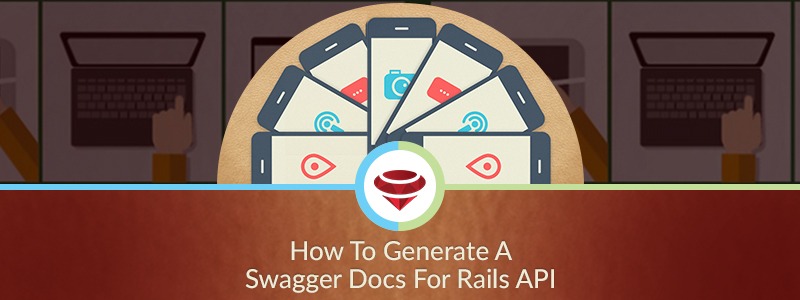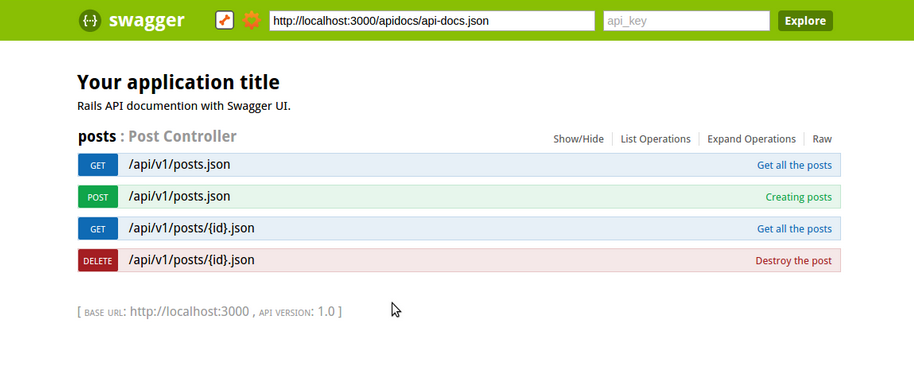Making API for a Rails application is simple for a Ruby on Rails developer. In any case, how different clients/customers will know whether the API is working fine or not without a customer side application. Is there any answer for this which I can report for API inside the Rails application, The answer is yes we have numerous instruments and methodologies however I would favor swagger UI.
In this article I am going to disclose how to make Rails API documentation using swagger UI.
Prerequisites:-
I am going to use one sample posts application which serves API calls.
Gem:-
To Integrate swagger UI for Rails API I am using a gem called swagger-docs. Add this gem to your Gemfile in your application and do bundle install.
Swagger initializer file:-
After bundling the gem create an initializer in config/initializers(e.g. swagger.rb) and specify the following options:
#File config/initializers/swagger.rb
Swagger::Docs::Config.register_apis({
"1.0" => {
# the extension used for the API
:api_extension_type => :json,
# the output location where your .json files are written to
:api_file_path => "public/apidocs",
# the URL base path to your API
:base_path => "http://localhost:3000",
# if you want to delete all .json files at each generation
:clean_directory => true,
# add custom attributes to api-docs
:attributes => {
:info => {
"title" =>; "Your application title",
"description" =>; "Rails API documention with Swagger UI.",
"termsOfServiceUrl" => "",
"contact" => ""
}
}
}
})
Refer below url for the list of configarations
https://github.com/richhollis/swagger-docs#configuration-options
swagger_controller and swagger_API are helpers to provide swagger UI documentation.
module Api
module V1
class PostsController < ApplicationController
respond_to :json
swagger_controller :posts, 'Post Controller'
swagger_api :create do
summary 'Creating posts'
notes 'Should be used for creating posts'
param :form, 'post[name]', :string, :required, 'name'
param :form, 'post[publish]', :boolean, :required, 'publish'
end
swagger_api :index do
summary 'Get all the posts'
notes 'Should be used for fetching all posts'
param :header, :Authoraization, :string, :required, 'Authoraization'
response :unauthorized
response :ok, "Success"
end
swagger_api :show do
summary 'Get all the posts'
notes 'Should be used for fetching a post'
param :path, :id, :string, :id
response :unauthorized
response :ok, "Success"
end
swagger_api :destroy do
summary 'Destroy the post'
notes 'Should be used for destroying a post'
param :path, :id, :string, :id
response :unauthorized
response :ok, "Success"
end
end
end
end
Ej:-
param :header, :Authoraization, :string, :required, 'To authorize the requests.'
param :path, :id, :integer, :required, 'post id that supposed to fetch the record'
param :form, :name, :string, :optional, 'name of the post'
param :query, :query_name, :string, :optional, 'query name'param – Standard API parameter
first value: parameter_type(types: form, path, header, query)
second value: name of the parameter
third value: datatype of the parameter
fouth value: required/optional
fifth value: Small description about the parameter
sixth value: list of values in sqaure brackets to hanle enums(optional)To handle enums:-
Pass list of enum values.
Ej:-
param_list :form, :payment_type, :string, :required, 'payment type',
[:check, :cash, :wire_transfer, :demand_draft]Generating json files:-
rake swagger:docs (Errors are not displayed by default with this command)
To see all error messages use the command below:
SD_LOG_LEVEL=1 rake swagger:docsSwagger UI integration
Please download swagger ui.
https://github.com/richhollis/swagger-docs-sample/tree/master/public/api
Before that please add below code to swagger.rb to
make a distinction between the APIs and API documentation paths.
class Swagger::Docs::Config
def self.transform_path(path, api_version)
# Make a distinction between the APIs and API documentation paths.
"apidocs/#{path}"
end
endCreate apidocs directory under public and api directory under apidocs.
Copy downloaded swagger-ui to the public/apidocs/api and index.html to public/apidocs.
Edit index.html
Change swagger url in window.swaggerUi function to url: “/apidocs/api-docs.json”.
It should be pointed to api-docs.json file under public/apidocs.
Because, it will generate under that path as per the configation we defined in swagger.rb
Now we all are set. IF you are running the the server stop and restart the rails server. Go to browser and try to access “http://localhost:3000/apidocs/indexâ€. You can click on available links(show/hide, List operations, Expand Operations and Raw) on each resource(posts etc):
Lea también: Track Changes To Your Model’s Data with Paper Trail Gem
Also read : Arquitectura multi-tenant con esquemas PostgreSQL
Want to learn more about our Rails development skills and past projects ? Ponerse en contacto with us now !







